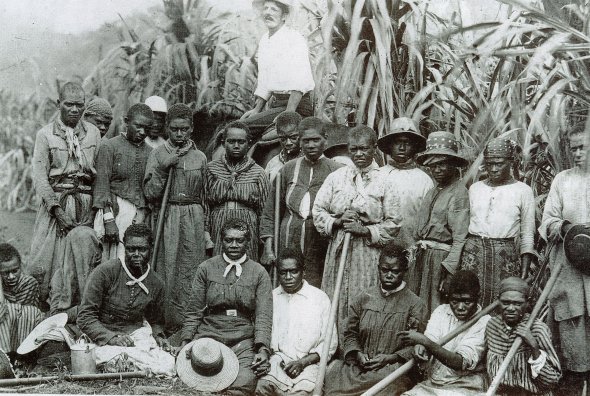
Introduction and establishment
Domestic rabbits were first introduced into Australia with the first fleet. They were imported on many subsequent occasions but did not become feral (дикий) except in Tasmania. It was after Thomas Austin brought 24 wild rabbits from England in 1859 and released them on his for hunting. In 1865, his farm was overrun by 20,000 of the little bastards. Austin received the credit (or rather, the blame) for the introduction of the rabbit to the mainland. Many other farms released their rabbits into the wild after Austin.
The establishment of the rabbit was initially regarded as a great success for the sporting gentleman. In 1866, only 7 years after its introduction, 14,253 rabbits were shot for sport alone on Austin's property. This was Australia's first intimation at the amazing reproductive capability of the rabbit from which the saying "breeding like rabbits" would work its way into the Australian lexicon.
Sometime in the 1850's a man was charged at the Colac (Victoria) Police Court with having shot a rabbit, the property of John Robertson of Glen Alvie. He was fined 10 pounds. A few years later, Robertson's son spent 5000 pounds a year in an attempt to control rabbits. By 1869 it was estimated that 2,033,000 rabbits had been destroyed on his property. This illustrates beautifully what happened so often in different parts of Australia.
Domestic rabbits were initially highly prized and many attempts were made to establish them, until the inevitable invasion of the wild rabbit only a few years later.
The spread of the rabbit across Australia
The rabbit spread from Austin's property and from other release points in both Victoria and South Australia. The rabbit took 15 years to reach the NSW border, another 15 years to reach Queensland and another 10 to reach Western Australia and the Northern Territory. Numbers were such that the movement of rabbits across the landscape was refered to as "a grey blanket". The Premier of New South Wales, Sir Henry Parkes offered a 25,000-pound reward to anyone who could come up with a solution to the rabbit infestation. By 1900 the rabbit was firmly established nationwide.
It was the fastest spread ever recorded of any mammal anywhere in the world.
Spreading across Australia may have taken a lot longer if it weren't for the sportsmen and trappers.
The English gentlemen felt quite at content (довольны) being able to shoot as they did `back home'. They could also congratulate themselves as accomplished shooters, shooting at times 1,200 in 3 1/2 hours, a figure unheard of in England. Rabbits were also spread by those whose pastime was game shooting (охота на дичь). These gentlemen took rabbits from shooting farms to establish them in their own regions and so the rabbit was transported around the country as game for sporting purposes.
"As the rabbits proliferated in numbers, the farmers began to bitterly complain, the sportsmen who were delighted, regarded the farmers as universal spoilers of gentlemen's sport".
The effect on the ecology of Australia was devastating. One eighth of all mammalian species in Australia are now extinct (rabbits are the most significant known factor), and the loss of plant species is unknown even at this time.
Rabbits are also responsible for serious erosion problems as they eat native plants which would have retained soil.
Economic impact
It would be difficult to exaggerate the economic and ecological impact of the rabbit prior. In good seasons there may have been one billion rabbits. As 16 rabbits eat as much as one sheep, this is equivalent to approximately 60 million sheep and the consequent loss of production. Australia spends more than $600,000 annually in trying to control the rabbit population and repairing damages they cause.
Rabbit control
Throughout Australia, shooters and trappers (rabbiters) were being hired as rabbits devastated crops and reduced the carrying capacity of the land dramatically. The rabbiters did not attempt to eradicate the rabbit completely as that would leave them without a job. The rabbiters were known to release rabbits whilst travelling to ensure work in that area. The rabbiters allowed the rabbit to procreate (размножаться) by not killing the young and by releasing trapped pregnant does (самки).
Many fences were erected to control the spread of the rabbits, yet these were mostly unsuccessful. Early fences were destroyed by wombats, rabbits, kangaroos, buried by sand drifts and because of the vast lengths of the fences, they were poorly maintained.
Rabbits were sometimes stopped by fences, but there were so many rabbits piled up by the fences, that the rabbits acted as a ladder for others that simply walked over the fence. Rabbits also will climb fences and they have been known to climb trees up to five meters.
The Rabbit-Proof Fence was built in Western Australia to try to control the rabbit population.
The State Barrier Fence of Western Australia, formerly known as the No. 1 Rabbit-Proof Fence, the State Vermin (вредители) Fence and the Emu Fence, is a fence constructed between 1901 and 1907 to keep rabbits and other agricultural pests (вредители) out of Western Australian pastoral (пастбищный) areas.
There are three fences; the original No. 1 Fence, which crosses the state from north to south, the No. 2 Fence which is smaller and further west, and the smaller east-west running No. 3 fence. The fences took six years to build. When completed in 1907, the Rabbit-Proof Fence (including all three fences) stretched 3 253 km. The cost to build the fences at the time was £337,841.
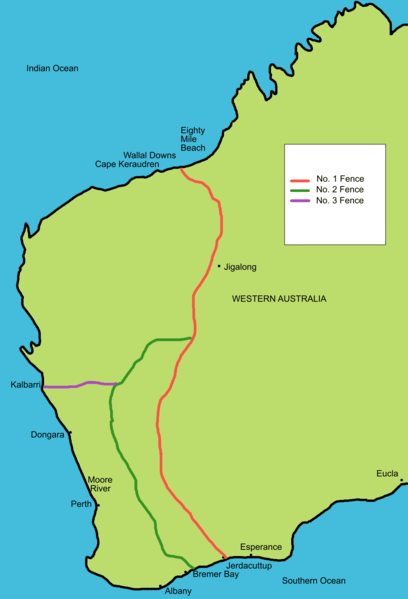
Map of the State Barrier Fence of Western Australia. Fence no. 1 (red), no. 2 (green), no. 3 (purple)
The virus disease Myxomatosis, which attacks rabbits, was introduced in 1950 and proved an effective control for about 20 years. Myxomatosis caused the rabbit population to drop from an estimated 600 million to around 100 million. Genetic resistance in the remaining rabbits allowed the population to recover to 200-300 million by 1991. The Australian Government refuses to legalise a vaccine to protect pet rabbits against Myxomatosis, and thousands of pet rabbit owners in Australia suffer losses of their pet rabbits each year. There is no cure for Myxomatosis, and many affected pets are euthanized.
Wool
Historically, wool was of key importance to the Australian economy, so much so (в такой степени, что) that the phrase ‘Australia rides on the sheep’s back’ is still a part of the Australian language.
For over 140 years wool was the mainstay (основа) of Australia's wealth. In 1835, it replaced seal (тюлень) and whale (кит) products as the country's major rural export, and retained that position until the mid-1970-s. In 1951 wool accounted for $1266 million, or 65% of Australia's total exports. Wool production has continued to rise, reaching a peak of 959 000 tons in 1988-89.
Wool production is less crucial (важный) today, the wool industry shrunk (сократилась) significantly in the 1990s due to low world prices and competition from synthetic fiber (волокно).
If Australia's wealth is based on wool, then the animals that must take most of the credit are the merino (меринос) sheep, which in 1989 made up three-quarters of Australia's 161 600000-strong flock (поголовье).
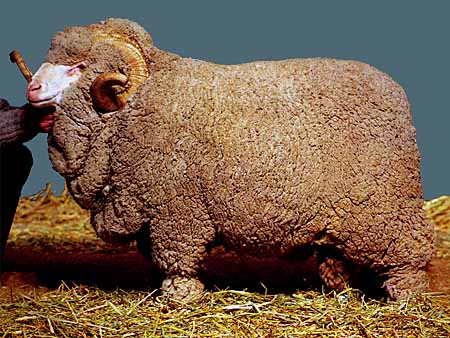
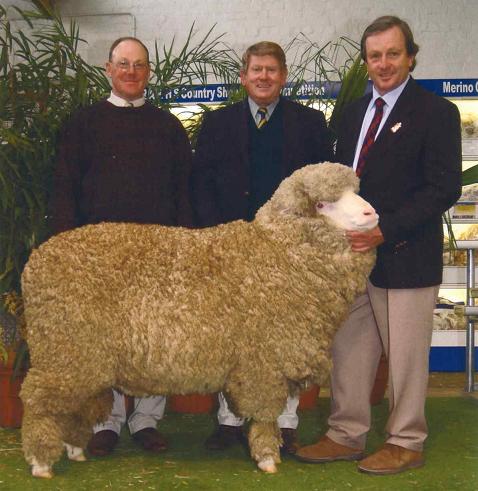
Originally from North Africa, they were introduced into Spain in the 12th century by Berbers, who were called Beni-Merines, and from whom the sheep's modern name is derived. Carefully guarded because of their valuable fleeces (овечья шерсть), merinos were for many years found only in Spain and Saxony, where a flock had been built up from animals given to the Elector of Saxony by the King of Spain.
Gradually, however, some animals found their way to other parts of the world. The first merinos to arrive in Australia were from the Сape of Good Hope flock, which was sold in 1797, at a time when two ships from Sydney were in Cape Town buying stock for the colony. In all, 32 merinos were acquired, but only 13 animals managed to survive the return journey to Sydney, where they were sold to prominent landowners. These animals, together with eight more purchased in 1804, formed the basis of Australia's merino flock.
Shearers (стригали)
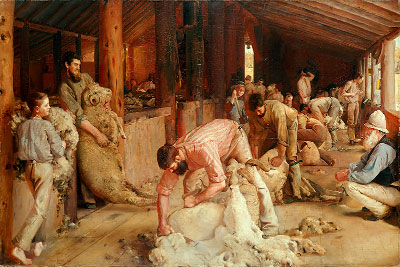
The champion of Australian shearers was the legendary John Robert Howe, who once held the world records for both blade and machine shearing. He was born in 1855, and was brought up around sheep and woolsheds, where he learned the art of blade shearing. He quickly gained a reputation for being both fast and accurate.
Howe became a full-time shearer in the 1880s. In October 1892, at Alice Downs in Queensland, he established the world hand-shearing record, with 321 ewes (овца) in 7 hours 40 minutes. On his last 11 days at the shed he was reported as shearing 149, 264, 131, 249, 257, 258, 262, 267 and 321 sheep, plus 190 lambs and 30 wethers (баран). Between Monday morning of one week and Monday evening of the next he claimed a grand total of 1758 animals. Twelve years later, on 16 July 1904, Howe shore, with the shearing machine, 337 sheep in 8 hours, thus adding to all his other achievement the machine shearing record. Howe died on 21 July 1920, aged 59, leaving behind him many records.
Howe's hand-shearing record remained unbroken until 30 September 1950 when W. E. Keick shore 326 merinos in an eight-hour day, at Brinard in Queensland.
In the 1860s sugar was successfully grown on plantations in Queensland. As the industry expanded throughout coastal Queensland and Northern New South Wales growth eventually became limited in the 1880s by high wages for farm labor. To overcome this problem, cheap “contract” labor was brought in from the South Pacific islands. Between 1863 and 1904, more than 60,000 Kanakas (канак - житель тихоокеанских о-вов, преим. Гавайских) were brought to Queensland to work on sugar plantations, some illegally through a process known as “blackbirding”. This involved Europeans luring (завлекать, заманивать) islanders onto ships by pretending that they wanted to trade with them, instead they were kidnapped and shipped to Australia where they were forced to work in sugar cane plantations.
Regulations were introduced in the late 1880s to control the import of Kanakas, and by 1908 many Kanakas had retuned home.
